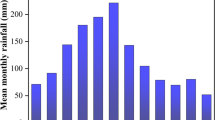Abstract
An older urban district in Wuhan, China, is transitioning from discharging sewage and stormwater directly into lakes, to directing the sewage to wastewater treatment plants (WWTPs). Dealing with polluted stormwater discharge is a great challenge. Stormwater runoff from an urban catchment with a combined sewer system was sampled and analyzed over a three-year period. Results indicate that wet weather flows account for 66%, 31%, 17%, and 13% of the total load of suspended solids (SS), chemical oxygen demand (COD), total nitrogen, and total phosphorus, respectively. The first flush of COD and SS was significant in all runoff events. More than 50% of the SS and COD loads were transported by the first 30% of runoff volume. Storage and treatment of the first 10 mm from each combined sewer overflow event could reduce more than 70% of the annual COD overflow load. An integrated solution is recommended, consisting of a tank connected to the WWTP and a detention pond, to store and treat the combined sewer overflow (CSO). These results may be helpful in mitigating CSO pollution for many other urban areas in China and other developing countries.
Similar content being viewed by others
References
Novotny V. Integrating diffuse/nonpoint pollution control and water body restoration into watershed management. Journal of the American Water Resources Association, 1999, 35(4): 717–727
Taebi A, Droste R L. Pollution loads in urban runoff and sanitary wastewater. Science of the Total Environment, 2004, 327(1–3): 175–184
Gnecco I, Berretta C, Lanza L G, La Barbera P. Storm water pollution in the urban environment of Genoa, Italy. Atmospheric Research, 2005, 77(1–4): 60–73
Suárez J, Puertas J. Determination of COD, BOD, and suspended solids loads during combined sewer overflow (CSO) events in some combined catchments in Spain. Ecological Engineering, 2005, 24(3): 199–219
Kim G H, Yur J H, Kim J K. Diffuse pollution loading from urban stormwater runoff in Daejeon City, Korea. Journal of Environmental Management, 2007, 85(1): 9–16
Chebbo G, Gromaire M C, Ahyerre M, Garnaud S. Production and transport of urban wet weather pollution in combined sewer systems: the “Marais” experimental urban catchment in Paris. Urban Water, 2001, 3(1–2): 3–15
Brombach H, Weiss G, Fuchs S. A new database on urban runoff pollution: comparison of separate and combined sewer systems. Water Science and Technology, 2005, 51(2): 119–128
Adams W R, Thackston E L, Speece R E. Modeling CSO impacts from Nashville using EPA’s demonstration approach. Journal of Environmental Engineering, 1997, 123(2): 126–133
Even S, Mouchel J M, Servais P, Flipo N, Poulin M, Blanc S, Chabanel M, Paffoni C. Modelling the impacts of combined sewer overflows on the river Seine water quality. Science of the Total Environment, 2007, 375(1–3): 140–151
Seidl M, Huang V, Mouchel J M. Toxicity of combined sewer overflows on river phytoplankton: the role of heavy metals. Environmental Pollution, 1998, 101(1): 107–116
Bilotta G S, Brazier R E. Understanding the influence of suspended solids on water quality and aquatic biota. Water Research, 2008, 42(12): 2849–2861
Arnold E G, Lenore S C, Andrew D E. Standard Methods for the Examination of Water and Wastewater. 20th ed. Washington DC, USA: American Public Health Association, American Water Works Association, Water Pollution Control Federation, 1998
Ebina J, Tsutsui T, Shirai T. Simultaneous determination of total nitrogen and total phosphorus in water using peroxodisulfate oxidation. Water Research, 1983, 17(12): 1721–1726
Sansalone J J, Buchberger S G. Partitioning and first flush of metals in urban roadway stormwater. Journal of Environmental Engineering, 1997, 123(2): 134–143
U.S. Environmental Protection Agency (USEPA). Results of the National Wide Urban Runoff Program Volume I—Final Report. Washington, DC: Water Planning Division, U.S. Government Printing Office, 1983
Sztruhár D, Sokác M, Holiencin A, Markovic A. Comprehensive assessment of combined sewer overflows in Slovakia. Urban Water, 2002, 4(3): 237–243
Ashley R M, Fraser A, Burrows R, Blandsby J. The management of sediment in combined sewers. Urban Water, 2000, 2(4): 263–275
Gromaire M C, Garnaud S, Saad M, Chebbo G. Contribution of different sources to the pollution of wet weather flows in combined sewers. Water Research, 2001, 35(2): 521–533
Chebbo G, Ashley R, Gromaire M C. The nature and pollutant role of solids at the water-sediment interface in combined sewer networks. Water Science and Technology, 2003, 47(4): 1–10
Kafi M, Gasperi J, Moilleron R, Gromaire M C, Chebbo G. Spatial variability of the characteristics of combined wet weather pollutant loads in Paris. Water Research, 2008, 42(3): 539–549
Gasperi J, Gromaire M C, Kafi M, Moilleron R, Chebbo G. Contributions of wastewater, runoff and sewer deposit erosion to wet weather pollutant loads in combined sewer systems. Water Research, 2010, 44(20): 5875–5886
Lee J G, Heaney J P, Lai F H. Optimization of integrated urban wet-weather control strategies. Journal of Water Resources Planning and Management, 2005, 131(4): 307–315
Lau K T, Butler D, Schütze M. Is combined sewer over overflow spill frequency/volume a good indicator of receiving water quality impact? Urban Water, 2002, 4(2): 181–189
Calabrò P S, Viviani G. Simulation of the operation of detention tanks. Water Research, 2006, 40(1): 83–90
Author information
Authors and Affiliations
Corresponding author
Rights and permissions
About this article
Cite this article
Li, L., Shan, B. & Yin, C. Stormwater runoff pollution loads from an urban catchment with rainy climate in China. Front. Environ. Sci. Eng. 6, 672–677 (2012). https://doi.org/10.1007/s11783-012-0447-2
Received:
Accepted:
Published:
Issue Date:
DOI: https://doi.org/10.1007/s11783-012-0447-2




